
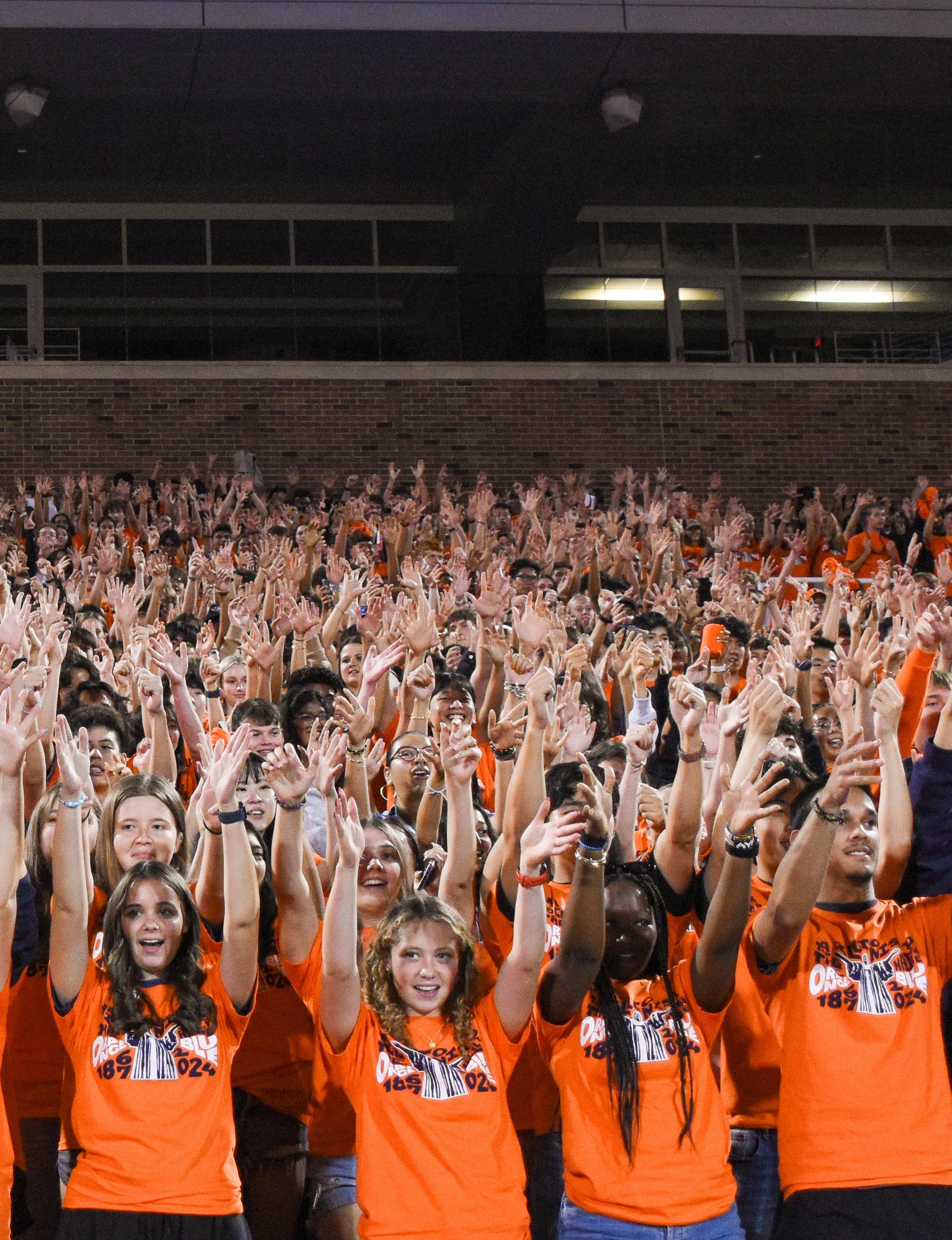





1001 S. Wright St., Champaign, IL 61820 || 217-337-8300
The Daily Illini is the independent student newspaper at the University of Illinois UrbanaChampaign. The newspaper is published by the Illini Media Company. The Daily Illini does not necessarily represent, in whole or in part, the views of the University of Illinois’ administration, faculty, staff or students.
Visit us in the basement of the University YMCA at 1001 S. Wright St. from 9 a.m. to 5 p.m., Monday through Friday.
Front Desk: 217-337-8300
Advertising: 217-337-8382
Newsroom: 217-337-8345
Reporting: If you have a question about a story or notice an error, email our Managing Editor at reporting@dailyillini.com.
Visuals: For questions about photos, graphics or The DI’s social media, email our Visual Director at visuals@dailyillini.com
Employment: The DI’s staff are current students at the University of Illinois. Visit dailyillini.com/applyto-the-di/ to learn more about our hiring process.
Tips: To submit a tip, email our News Editor at news@dailyillini.com or submit a confidential tip online at dailyillini.com/contact/
Corrections: When we make a mistake, we will acknowledge it with a correction. We strive for accuracy, so if you notice an error, please email our Editorin-Chief, Sam Gregerman, at editor@dailyillini.com
Letters to the editor: Letters are limited to 300 words. Contributions must include the author’s name, address and phone number. University students must include their year in school and college. The DI reserves the right to edit or reject any contributions. To submit a letter, email opinions@dailyillini.com with the subject line: “Letter to the Editor.”
All Illini Media Company and The Daily Illini’s articles, photos and graphics are the property of Illini Media Company and may not be reproduced or published without written permission from the publisher. The Daily Illini @TheDailyIllini @DI_Sports
Placing an ad: If you would like to place an ad in our next print edition or on our website, call our advertising department at 217-337-8382 or email advertise@illinimedia.com.
Editor-in-Chief Sam Gregerman editor@dailyillini.com
Managing Editor Maaike Niekerk reporting@dailyillini.com
Visual Director Matt Stepp visuals@dailyillini.com
Special Sections Editor Chloe Barbarise specialsections@dailyillini.com
News Editor Qaasim Jatoi news@dailyillini.com
Arts & Entertainment Editor Annisyn Krebs-Carr entertainment@dailyillini.com
Sports Editor Brendan Gallian sports@dailyillini.com
Copy Chief Ian Cunningham copy@dailyillini.com
Photo Editor Isaac Pinkus photo@dailyillini.com
Graphics Editor Rikkie Gunawan graphics@dailyillini.com
Design Editor Hadyn Nuttall design@dailyillini.com
Audience Director Audrey Lutz social@dailyillini.com


@thedailyillini

EDITOR-IN-CHIEF
SAM GREGERMAN editor@dailyillini.com
The time has come for another school year! I would like to personally welcome you to the University of Illinois on behalf of The Daily Illini.
For those unfamiliar, The DI is the University’s independent student newspaper — and your new go-to for campus and community news.
While you’ve hopefully spent your break kicked back and relaxed, our team of writers and editors has compiled a collection of articles for you to read during these last few fleeting weeks of summer.
We mail out our New Student Edition annually to the incoming class of freshmen and transfers, intending to provide you with stories about University hot topics and things we firmly believe you should know before setting foot in
Champaign-Urbana.
If you’re grappling with a conflict between intrigue and fear of networking, go no further than flipping to page 4 for some tips and tricks on building professional connections.
Perhaps you want to break through into what our University is known for: research. Don’t know how? News Editor Qaasim Jatoi provides valuable insight on page 9.
Wondering what happened last year with Illinois football? A recap of the 2024 season will prepare you for tackles and touchdowns to come on page 25.
Or maybe you’re like me: a transfer student with some college experience in your back pocket already. I dive into how transferring schools made me a better student, Illini and person on page 35.
Starting at a new school isn’t easy, but we’re here to help bridge that college knowledge gap. Focus on the excitement, take a deep breath and remember this is your time to shine!


MATT STEPP THE DAILY ILLINI
The Class of 2028 is welcomed to the University during Illinois Sights & Sounds at Memorial Stadium on August 22, 2024. Student ambassadors, the Marching Illini, Illinois football, and men’s head basketball coach Brad Underwood were among the people who greeted students in the stadium.
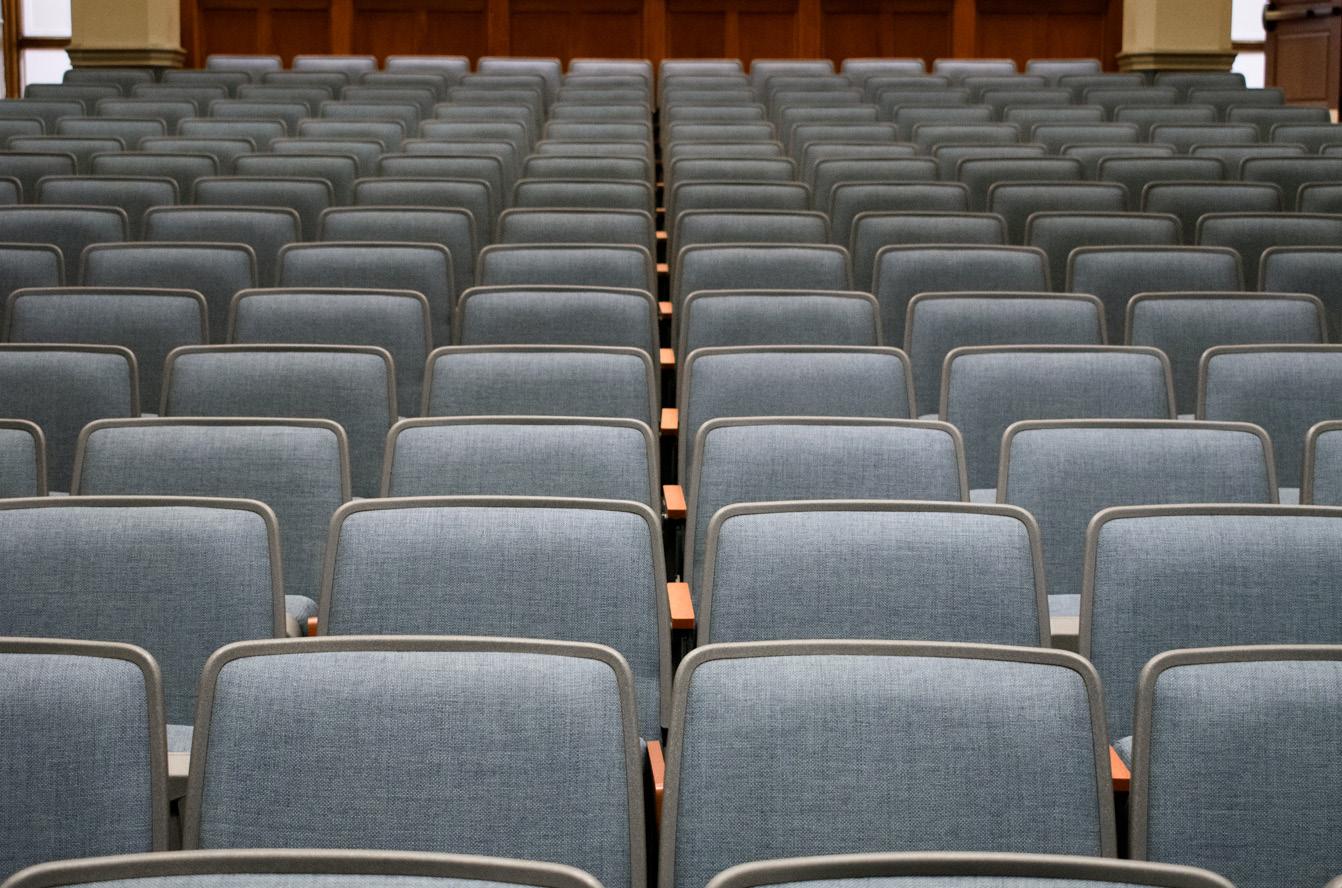


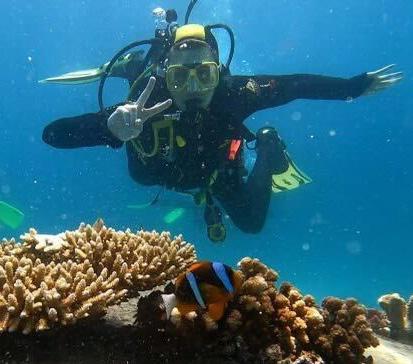

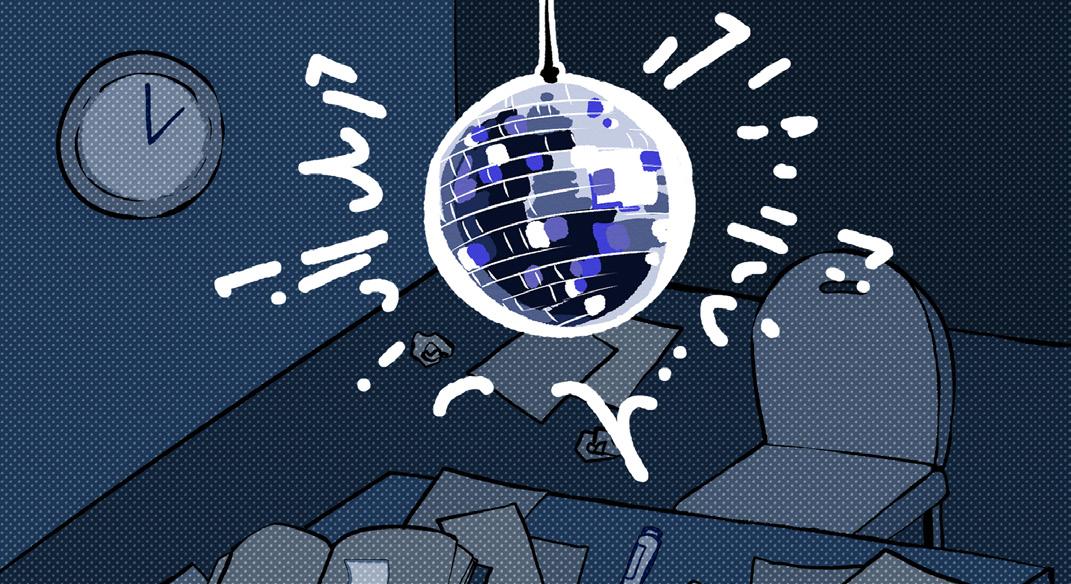
How to build a network at UI and beyond
UI professors stress importance of attendance
Professional RSOs: From day 1 to dream job
Students fuel innovation at UI
UI librarians share services, purpose for undergraduates
UI students debunk ‘useless majors’
Study abroad transforms the unknown into home
The new student’s guide to Greek life
Opinion | The fine art of calling your parents in college
Nutritionally navigating the dining halls
Strong 2024 season brings high expectations for Illinois football
Illinois’ rivalries through the years
Outdoor gems for connecting with nature
Opinion | ‘Dancing Myself Clean’: College as a lecture on loneliness
DI Voices | Finding myself through transferring
AVERY PATERSON
averyep2@dailyillini.com
Networking. For many freshmen newly arriving on campus, the word evokes a multitude of heavy associations. In its vagueness lurks the threat of awkward coffee chats, nagging emails and forced connections.
Regardless, most college students today are taught that networking is the key to landing positions and jump-starting a career. In other words, this intensely intimidating ritual seems necessary to secure a future — how do you pull it off?
Jordari Rene, assistant director of employer relations and professional connections at The Career Center, underlined that networking doesn’t have to be an overwhelming term.
“Networking is understanding and honing relationships between different individuals while also gaining information or exchanging information with one another,” Rene said. “Anyone can get involved. I’m talking about your friends, your professors, your mentors, the person down the road.”
Rene and his team host more than 10 career fairs throughout the year, including college-specific and part-time job fairs. The office also hosts the annual Diversity & Inclusion Networking Exchange, a dinner for students to meet with professionals in their field.
Media Career Services
hosts two or three Media Career Nights per semester, where alumni working in different sectors of the industry provide insight to students.
Daniel Almanza, assistant director of career services at the College of Media, said they also hold annual “Meet the Recruiter” nights. These provide opportunities to discuss open positions with companies directly.
“It really allows students to understand different types of industries, but more than anything, be able to start connecting with these different professionals and gain insight and advice from these particular individuals,” Almanza said.
Before attending one of these events, though, preparation is crucial.
“It never hurts to do a little bit of background research,” Rene said. “We do our due diligence to make sure that we give you the information of who’s going to be there, the amount of people. We even give you a dress code.”
Almanza also suggested polishing your resume at The Career Center beforehand, as well as reaching out to upperclassmen for guidance.
While career fairs can be useful opportunities for expanding your network, students also credit pre-professional organizations with broadening their connections.
Natalie Wietzema, senior in Business, is the president of Phi Chi Theta, one of several business fraternities on campus that aim to promote professionalism and leadership among its members.
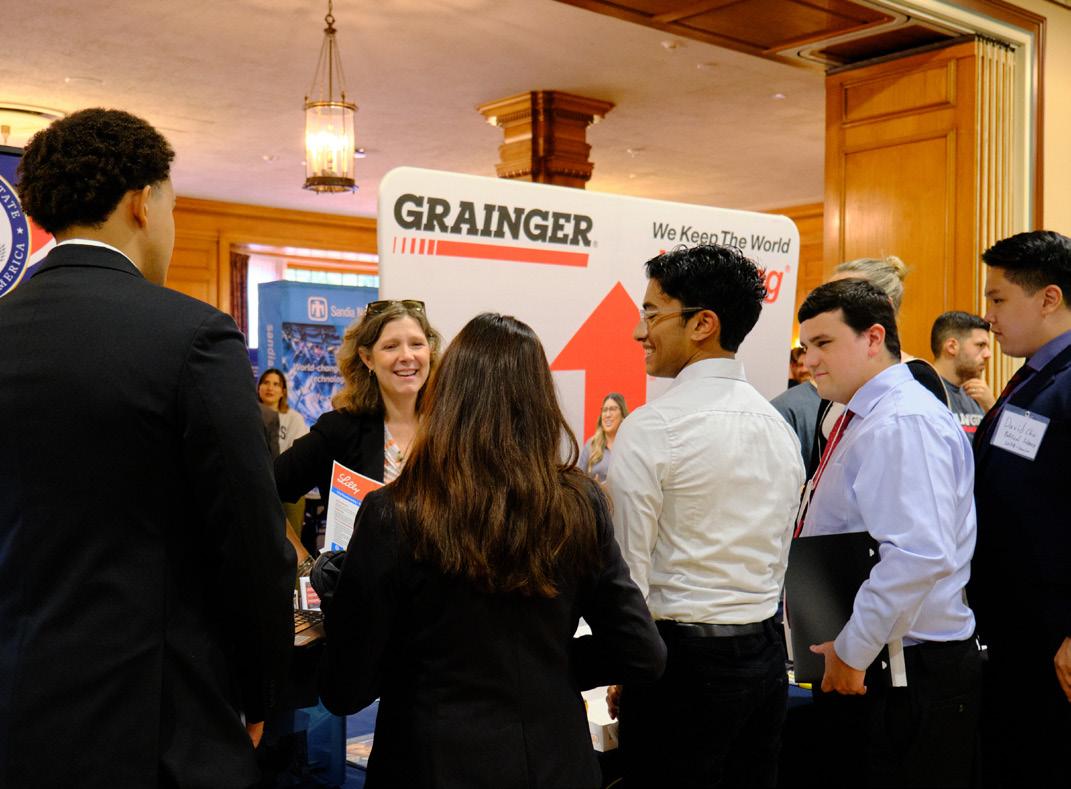
“My favorite part of being part of the organization was we got to do a lot of coffee chats,” Wietzema said. “It was a really cool opportunity to meet new people, meet seniors in the organization if you were a freshman or sophomore and learn from different people’s experiences.”
Students across campus swear by these “coffee chats” — informal conversations with a peer or higher-up about an industry or position, often done over a cup of coffee. Another must-know in the college networking glossary is the employment platform LinkedIn.
“(LinkedIn) is useful when making connections,” Wietzema said. “I think it’s just another useful platform to get to know different people’s experiences because you might not see that through Instagram or Snapchat.”
During Wietzema’s sophomore year, an employee of a company she hoped to work for appeared on her
LinkedIn feed. After reaching out to the profile and being connected with a recruiter, Wietzema landed a position at the company for the following summer.
LinkedIn is popular across campus, the nation and the globe. Handshake is another prevalent platform at the University that may offer more local opportunities.
Almanza offered advice to those who feel uneasy about forming professional connections.
“These different seasoned professionals and different people you meet, they’re really eager to meet you,” Almanza said. “As much as you might be sort of more timid or shy … oftentimes, it’s them wanting to get to know you.”
Whether the idea of networking conjures enthusiasm or apprehension, the University has a wealth of resources prepared to help students build relations successfully, from the moment they set foot on campus.
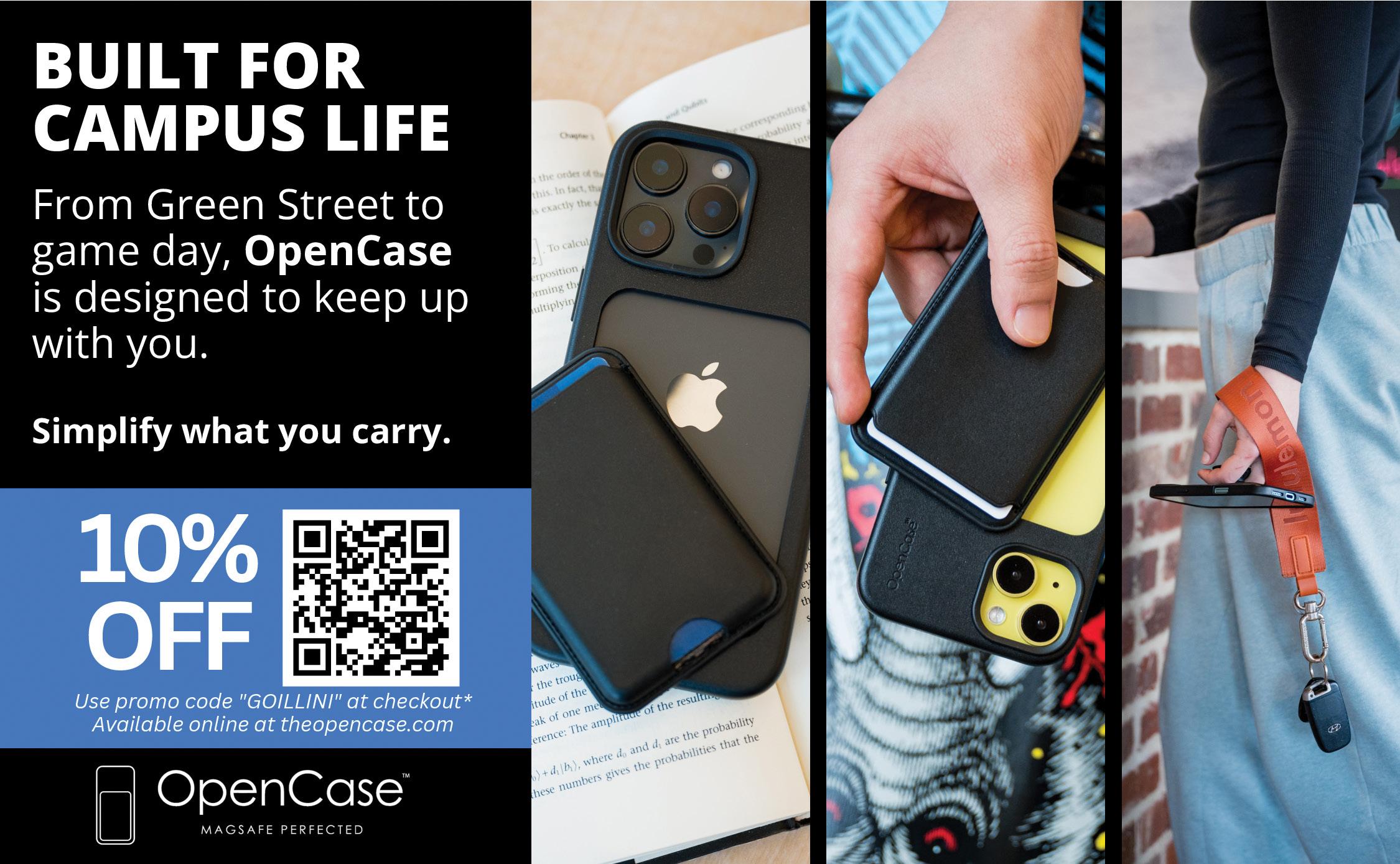


SUMMER EDITOR ANNA WILLIAMS akw5@dailyillini.com
College is a freeing experience. Released from the framework of their homes, students can decide many things for themselves for the first time: when to go to bed, when to wake up, what to eat and how to structure their day.
However, this freedom also brings a new lack of accountability. The lessened supervision in college means that students can avoid studying, party late, sleep all day and, most importantly, skip class.
Although not out of place in high school, skipping becomes an entirely new monster in college. Three University professors from popular freshman classes gave their perspectives on the culture of skipping and why attendance is essential to student success.
“At its core, coming to class is about much more than hearing a lecture,” said Brian Dill, professor in LAS and instructor of SOC 100: Introduction to Sociology. “Sociology, in particular, often asks students to engage with unfamiliar ways of thinking about the world.”
Most University classes use a combination of online and
in-person learning, often posting resources on class sites to supplement lectures and discussions. Dill emphasized that even though the basic message of the classes can be understood from their online content, engaging with the material in person is a crucial part of the learning process.
“Being present allows students to ask questions, engage actively and hear how others are making sense of the material,” Dill said. “These moments often cannot be fully captured by simply reviewing lecture slides on Canvas.”
Many classes’ attendance policies allow for an excused absence. Every class has different attendance expectations, including giving students a certain number of free passes or providing a channel of communication to explain their absence to the instructor. The policies allow students to have flexibility with their schedules without missing too much content.
“We’re hoping students are going to transition from the high school way of thinking about attendance to the college way of thinking about attendance,” said Lisa Travis, professor in LAS and lecturer of PSYC 100: Introductory Psychology. “The high school way of thinking is, ‘If I don’t
attend, I’ll get in trouble,’ and the college way is more, ‘If I don’t attend, I won’t learn the things I need to learn and want to learn.’”
Studies show a positive correlation between attendance or engagement and performance in a class, and University professors concur with their own statistics. Professors highlighted that students who attend lectures or discussions often perform better overall in the class.
“This past spring, in my in-person STAT 100 section, students who attended (more than) 75% of classes had an average final grade of a 94%,” said V.N. Vimal Rao, professor in LAS and instructor of STAT 100: Statistics. “Students who attended less than that had an average final grade of 86%.”
Although the cause-andeffect relationship is not always clear, multiple professors pointed out some type of correlation.
“We keep track of attendance in Introductory Psych, and we look at how that relates to final grades, and we find a correlation in the range of 0.6 … so we know they’re strongly related,” Travis said. “The thing we teach to students in PSYC 100 is, ‘Don’t interpret correlation as causation’ — it may not be that the attendance causes you to get better
grades, but we certainly know they go together.”
Overall, professors encourage students to consider not only themselves when they skip but also the impact it could have on the learning environment.
“One of the most important sources of learning is your peers,” Rao said. “When you haven’t done your work, you impact your own learning as well as that of your classmates.”
Professors’ most repeated message was that even if it might seem worth it in the moment, skipping class has far-reaching impacts on a student’s performance and their classroom environment.
Travis emphasized that students should frame the question in more positive terms, using the reasons why they want to be in class instead of what the consequences would be if they skipped.
“Be aware that now that you are an adult, it’s your choice to make whether you attend this class or not,” Travis said. “But there’s a reason why we ask you to attend … just think, ‘What am I here for? What do I want to get out of this experience?’ And if you think about that hard enough, you’ll probably realize that it isn’t just to accumulate points.”

KATHYA GRAU
kgrau2@dailyillini.com
When you first arrive on campus, your mind is likely on finding classes and adjusting to life with a roommate, not your future career. And it’s perfectly normal.
As things settle, you may start thinking about how to make your time at the University count in the long run. That’s where professional RSOs come in.
These student-led groups connect you with peers in your field, help you gain practical experience and de-
velop skills that prepare you for life after graduation.
Whether you know what you want to do or are still figuring it out, joining one can open unexpected doors right before you.
Illinois Model United Nations allows students to travel, debate policy and simulate international diplomacy.
The Society of Women in Public Affairs supports women interested in law, government and public service through panels, workshops and networking events. Ava Basolo, ju-
nior in LAS, joined SWPA her first year after meeting members at Quad Day.
“I saw myself growing here, both personally and professionally,” Basolo said.
Through SWPA, Basolo improved her speaking skills, gained confidence in interviews and landed a summer internship.
“The workshops, especially those on leadership styles and public service, helped me shift my perspective and work better in teams,” Basolo said.
Other RSOs in the College of Liberal Arts & Sciences include the Undergraduate Psychology Association, ideal for students
pursuing careers in mental health or research. It offers faculty connections, guest speakers and grad school resources.
The Economics Club hosts study groups, faculty talks and company information sessions, while the Global Studies Professional Society focuses on international careers and global policy.


NEWS EDITOR
QAASIM JATOI qjato2@dailyillini.com
When people think of research, they probably picture microscopes, lab goggles or someone mixing liquids in a glass beaker. While that’s part of it, research at the University can also mean programming evolution models, analyzing cancer disparities, engineering human cells and conducting thousands of other experiments. In many of these projects, undergraduates play an active role.
With annual research funding growing past $700 million in recent years, the University enables students to contribute to impactful work. Upon doing so, they improve their skills and confidence.
Jenny Zhu, junior in LAS, initially searched for research opportunities within her department — molecular and cellular biology — but was discouraged when her cold emails went unanswered or were met with a lack of open positions.
Encouraged by her roommate, who studies materials science and engineering, Zhu expanded her search and emailed Hua Wang, a professor in that department with a biology-related lab. Zhu received a positive response from him.
“Sometimes you just have to be persistent,” Zhu said. “I took a chance … and that’s how I ended up joining the Wang Lab.”
The Wang Research Lab is engineering human cells to improve immune responses to diseases, including cancer. Experiments don’t always go as
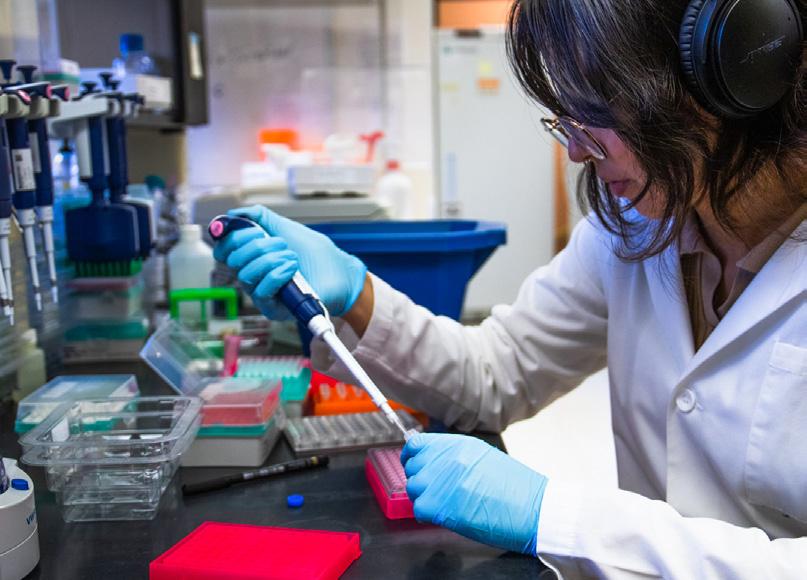
planned. However, Zhu values the adaptability she’s attained from this experience.
“Learning from (when experiments go wrong) — troubleshooting — is a huge part of research,” Zhu said. “Building that problem-solving skill is really valuable even beyond the lab.”
Balancing research and coursework is a challenging task. To achieve this, Zhu emphasizes the importance of time management. She said she’s built lasting relationships with her labmates and enjoyed the process of learning and asking questions.
Cancer research at the University isn’t just confined to biology or engineering labs.
In ACES’ Department of Food Science & Human Nutrition, professor Zeynep Madak-Erdogan’s Women’s Health and Metabolism Lab is investigating cancer disparities. She uniquely focuses on how social and environmental factors influence one’s health.
Hannah McGee, senior in LAS, works in Madak-Erdogan’s lab. The team connects molecular and cellular biology — McGee’s major — with metabolic and neighborhood-level influences to uncover drivers of cancer outcomes.
“When I started college, I wasn’t interested in research,” McGee said. “It
SAM RINK THE DAILY ILLINI
Gisselle Rosas Camacho, a visiting research specialist at the DNA Services Lab in the Roy J. Carver Biotechnology Center, pipettes DNA samples on Nov. 7, 2024.
sounded so boring.”
But an assignment motivated her to contact Madak-Erdogan, whose work resonated deeply with what McGee experienced growing up in Chicago. It was the first time she felt a genuine connection to research.
“I found papers that interested me and connected (to) my own life,” McGee said. “I emailed her and, within a day, she responded.” She credited the positive response to showing her genuine interest in the work and citing examples of papers the lab published.
McGee has spent over two years in the lab. Growing her research portfolio, she’s contributed to publications and presented her work at symposiums. Each time, her confidence grows.
“Putting yourself out there and presenting really improves public speaking skills — the way I present myself and convey ideas,” McGee said.
For McGee, conducting research has been “free career development” — an opportunity to gain valuable skills without a cost.
“I’m giving my time, and I’m getting all these skills that are so valuable to my own development and so valuable to other people, like employers,” McGee said.
In another corner of campus, Mohammed El-Kebir, professor in Engineering, was honored last year for excellence in mentoring undergraduate research. El-Kebir leads a computational biology lab on reconstructing tumors’ evolutionary histories. It is a complex challenge given diverse mutations and fragmented genomic data.
His lab attracts computer science and biology students. El-Kebir said there are computer science students who were never interested in biology before. Similarly, he said there are biology students who became interested in the computer science aspect of the lab’s work.
El-Kebir encourages students to establish connections with professors via courses rather than cold emails. Cold emails have a lower success rate in landing research, he said.
“The professors that do research typically teach upper-division courses with a research project, and that’s a good opportunity to start working together,” El-Kebir said. “That’s the more natural choice.”
According to El-Kebir, all undergraduates should try researching for at least a semester. He said it helps them develop unique skills and gain recommendations from respected professors.
“Research requires a variety of skills that you don’t typically apply in a classroom setting,” El-Kebir said. “Even if you’re not going to end up going to grad school … companies can be very interested in that. It’s good just to be exposed to something outside of classwork.”
MANAGING EDITOR
MAAIKE NIEKERK maaiken2@dailyillini.com
When tasked with serving a population of nearly 60,000 students, the University faces no small feat. Accommodating so many people and creating space, resources and staff to welcome all of them each year is undoubtedly difficult.
One area in which the University rises to the challenge? Its library system.
“This is one of the best libraries in the world, pretty much any way you look at it, certainly by size,” said Claire Stewart, Juanita J. and Robert E. Simpson dean of libraries. “And it’s not just the size, it’s some of the very significant strengths we have, particularly in our International and Area Studies Library, our Rare Book and Manuscript Library, but also the people here.”
Illinois is Stewart’s fourth Big Ten library, after having spent multiple years at Northwestern University, the University of Minnesota and the University of Nebraska-Lincoln. She’s worked with impressive libraries before, but at Illinois, she serves the largest public university research library in the country.
So, how does this library system work to serve undergraduate students?
According to Megan Sapp-Nelson, head of the Grainger Engineering Library Information Center, a valuable resource for students can be the buildings themselves.
“Oftentimes, when people need baseline information to make new knowledge or create new things, they need areas for collaboration,” Sapp-Nelson said. “They need areas for reflection. They need areas for being able to explore their creativity and their curiosity. And that is fundamentally what a library is.”
Grainger Engineering Library, the largest engineering library nationwide, is known for being open 24 hours on weeknights, offering students a reliable place to lock in and focus on their assignments.
“The ability to be able to focus is an increasingly difficult task with how much stimulation there is from the internet, social media, streaming, television,” Sapp-Nelson said. “Having a designated place that cues you that ‘This is a time to focus’ is also really valuable in this society, and libraries provide that.”
Grainger offers a wide variety of resources for students beyond its 1,500 individual study seats — nearly all of which fill during finals season, according to Sapp-Nelson. On its lower level, the building houses the IDEA Lab, which includes a virtual reality and esports suite, a 3D printing studio and even a sewing and embroidery machine.
Emerging technology can also be found at Grainger, with items such as high-quality cameras, recording equipment and sound booths for student use. For students who aren’t intent on get-
ting homework done at the library, Espresso Royale resides on the first floor, along with a popular materials collection for students to enjoy more casual reading.
Despite its enormous presence on the north side of campus, Grainger is far from the only library offering unique resources to undergraduate students. Stewart emphasized the need for an all-encompassing library system, not just focusing on one subject like engineering — and also not on any one level of education.
“We have to serve every single discipline, and a whole range of expertises, from undergrads who are taking their first year all the way up to faculty — professors who are the best in their class and your world-renowned researchers,” Stewart said. “They all rely on us, in some way or another, to help with their information.”
Sitting on the opposite side of campus, the Funk ACES Library, headed by Sarah Williams, seeks to bring the University population together with its open, welcoming atmosphere.
“We know that the whole library system is very big and complicated,” Williams said. “We’re open to anyone, and if people have questions about the library, they shouldn’t hesitate to ask.”
Funk hosts the second-longest building hours after Grainger, staying open until 2 a.m. Sunday night through Thursday night. The library’s quiet environment, big windows and well-cushioned
chairs make it an ideal spot for cramming for an exam or planning your next big essay.
The library’s big space is populated by a surplus of print journals and resources, but Williams emphasized the equal importance of having digital items available to students. Funk is just one of the University libraries that has been working to expand its digital collection, making previously unattainable items easier to access.
“If people are off doing research elsewhere or there are students who are taking classes remotely, it’s just accessible to people,” Williams said. “Even if somebody needs to access an article from the 1980s, it’s quite possible that we have online access to that as well.”
Stewart echoed that the University’s shared system with other libraries might not be as well known to students, especially incoming undergraduates. The University shares resources with the UI System, the Big Ten and even locations across the globe.
“I think one of the best services that tends to be a little more hidden is our interlibrary loan services,” Stewart said. “Literally, the goal is, if you need something and we don’t have it, but it’s in a library somewhere in the world, we have a service whose sole purpose is to try to get it for you.”
Bringing international services on campus for student use is a specialty of the Communications Library. Tucked away in Gregory Hall, the li-
brary that began as the Journalism Library has evolved to encompass multiple disciplines across colleges.
Lisa Romero, communications librarian and librarian for Latina/o studies, described a unique resource found in her library — a collection of international newspapers for students to access.
“We have access to international news from all over the world,” Romero said. “We have news from India, Mexico, Europe, the Middle East. It’s very important to (international students) because they want to have access to a news source that they’re familiar with … Those different news sources give us different perspectives.”
Romero was one of multiple librarians who emphasized the importance of a comfortable, inclusive space. Though different libraries are named for different dis-
ciplines, their buildings and resources are available to all, regardless of college or major.
Kate Lambaria, music and performing arts librarian, said that while campus is undoubtedly large, this just means more opportunities for the student body. Any appreciators of music can utilize her library. The Music and Performing Arts Library doesn’t just house classical composers like Beethoven and Bach but works from modern-day pop stars like Taylor Swift and Beyoncé.
“I think people hear ‘Music Performing Arts Library’ and think they have to be a music or dance or theater student to use the space — they don’t,” Lambaria said. “We are open to all students, regardless of major or area of study.”
Any students using the MPAL can utilize the space’s DVD, CD or record players,
as well as the two keyboards housed in separate rooms for students to pluck out melodies while studying. Whatever ultimately piques their interest, libraries have so much more than what’s on the surface, Lambaria said.
“There’s also the more well-being type services that we offer, when we try to do de-stress stuff around finals week or the food pantry in the Main Library,” Lambaria said. “If you have this idea of a library being a space where you just go and be quiet, there are books around and that’s it … that’s not really what libraries are.”
Even considering its current size, the University library system is always looking for ways to grow, Stewart emphasized. A large part of this comes from student participation and feedback on the places made entirely for their use.
“The goal is to have a single place that’s entirely focused on student academic success, but it needs to be driven and reshaped over time by the students themselves,” Stewart said. “So tell us what you want. Tell us what’s missing.”
Whether you’re completely new to campus or returning for your final academic year, think about breaking free from your dorm room or apartment and heading over to the nearest library. The librarians assure you, you won’t regret it.
“Sometimes I hear from students, in their senior year, they come to the library and they ask for assistance with research, and so often they tell me, ‘I really wish I would have used the library more when I was a freshman,’” Romero said. “If there’s one thing I can encourage students to do, it’s get acquainted with the library space.”

STAFF WRITER
SIENNA NICOSIA snico6@dailyillini.com
It’s no secret that choosing a major is a stressful decision, especially with the added pressure of needing to pick a perfect career in a world of unstable job markets.
Some majors can be criticized for their unreliability when considering the effort and money put into them during one’s undergraduate years. These remarks can persuade students to pursue majors with high-paying, in-demand jobs like computer science.
However, while some
majors may not lead to an immediate job offer, that doesn’t mean they’re not worth it. One of those hidden gems is music instrumental performance.
“I chose to pursue a music degree because there is just so much flexibility with pursuing one,” said Audrey Ringle, sophomore in FAA. “It’s like a personal love that you can share with other people, which is always a fun thing.”
Ringle believes that with a music instrumental performance degree, there are numerous opportunities depending on the amount of dedication to the career. The possibilities are end-

less, ranging from teaching classes and performing with a group to making your own music.
“I’m hoping to get a master’s degree in trombone performance and pursue local orchestral gigs and acquire students to teach private lessons to,” Ringle said. “There are a variety of things that all go into being a professional musician.”
According to Ringle, other students dismiss music instrumental performance because they feel the major doesn’t require as much work. However, by studying trombone performance, Ringle dedicates much of her time to practicing, re-
hearsing and performing in concerts consistently.
“The common thing to say is, ‘Oh, you’re a music major; it’s not a real major,’” Ringle said. “People think all you have to do is play your instrument and do nothing. That’s definitely far from it. I feel like music majors are the busiest people I know.”




CHLOE BARBARISE chloeb4@dailyillini.com
Jack Thornton had never snorkeled before. He didn’t even own a mask, often borrowing one from someone.
But once he dipped beneath the surface of the Australian water, the commercial beach Thornton viewed from above didn’t appear the same from below. Stingrays, small sharks and arrays of vibrantly colored fish surrounded him.
Thornton, a 2025 University alum, studied abroad at the University of New South Wales Sydney in Australia from January to May 2024 but extended his stay through June. He studied statistics and philosophy throughout his four years at the University but will now pursue a postgraduate program in marine biology — thanks to his newfound love for the ocean.
“Growing up in the Midwest, I had never really experienced the ocean or life near the ocean,” Thornton said. “(Studying abroad) really opened me up to a passion that I didn’t even know I had.”
Illinois Abroad and Global Exchange, the campus study abroad office, offers more than 250 programs in over 60 countries, according to Director Joy Phaphouvaninh. The office collaborates with each college’s study abroad office, tailoring programs to students of all majors and academic needs.
University students participate in various programs abroad that can range from a

few weeks to an academic year. Much participation stems from programs in Europe, but Phaphouvaninh said lesser-known but equally strong opportunities lie in Panama, Brazil and South Africa.
“We are proud that Illini can study abroad in such a diverse list of countries and in different types of programs and encourage students to identify what is most important to them in an experience,” Phaphouvaninh wrote in an email to The Daily Illini.
However, Daniel Maroun, undergraduate adviser and study abroad director of the French programs, sees Europe’s popularity firsthand. Maroun focuses primarily on programs in Paris, which he describes as “irreplaceable.”
“There is nothing better than Paris,” Maroun said. “And I only say that because this is the world’s number one tourist destination, and so people dream of it. So it’s not a tourist destination for our students because it becomes a home.”
But that No. 1 tourist destination spot doesn’t stop students from venturing beyond to other French cities, like Toulouse and
Jack Thornton, a 2025 University alum, goes scuba diving in the Great Barrier Reef in Australia and poses with a clownfish on Feb. 13, 2024.
Marseille, to find what best suits them, Maroun said.
In his advising sessions, Maroun begins by exploring students’ academic and personal interests, helping them navigate common concerns like housing and coursework. Students also take pre-departure and reentry courses to prepare for and reflect on their experiences abroad.
For Maroun, studying abroad means immersing oneself in the unfamiliar — new people and places can lead to unexpected growth and a deeper appreciation for what was once unknown.
“I want people to have worldwide experiences that aren’t
unique to the United States,” Maroun said. “We don’t have complaints from students coming back being like, ‘I wish I didn’t do that.’ They all are like, ‘Oh my God, I wish I could keep going.’”
Yet, the desire to stay in Australia came with complications for Thornton. He enjoyed the 45-minute walk to the beach but struggled with the distance from his loved ones. However, without the experience, Thornton knew he wouldn’t have changed as much as he did.
“There were times when I absolutely hated it, and there were times when I absolutely loved it,” Thornton said. “I was super homesick and anxious on certain days, and there were certain days when I was with friends who I would have never met, doing things that I never would have done … You can never really be certain if you will absolutely love a place or not, but if you’re willing to take the risk, then I think it’s worth it.”



CONTRIBUTING WRITER
ELIZABETH BICHKOFF emb10@dailyillini.com
As an incoming freshman, the opportunities to network and expand your horizons on campus seem limitless. Among the largest and most prominent RSOs on campus are fraternities and sororities.
The Fraternity & Sorority Affairs website offers an overview of information about recruitment, philanthropy and each council’s values. Students can start to form an idea of which council best matches their interests and find information on the existing Panhellenic Council, United Greek Council and Interfraternity Council websites. Information about the Black Greek Council can be found on the FSA website.
In addition to this wealth of information, executive board members shared personalized insights with The Daily Illini. They also ad
dressed common misconceptions to help incoming freshmen with what they should know about fraternity and sorority life.
One important distinction board members made was the relationship between the four councils and FSA. Interfraternity Council President Ross Bodine, senior in ACES, explained that while the office provides guidance and oversight, the councils are independent, student-run organizations.
“We don’t work for the office, but they do have a hand in a lot of things that we do,” Bodine said.
While FSA and the councils both shape the Greek life experience at the University, their responsibilities are significantly different. As a unit under Student Success, Inclusion & Belonging, FSA provides oversight and ensures that Greek life organizations recognized by the Uni
versity follow campus policy.
On the other hand, councils and their chapters are student-governed, managing their own daily operations. Bodine explained that the University typically takes a hands-off approach, encouraging student leadership on campus and only stepping in when necessary. While responsibilities between the two differ, the relationship between them is meant to be collaborative and democratic, allowing for student leadership while upholding University policy.
While all four councils participate in similar events meant to promote recruitment, like Quad Day, they also have individual events that are specific to their respective councils and chapters.
The BGC and UGC both participate in an event that showcases their chapters to students. Dan Statam, BGC president and senior in ACES, described Meet The
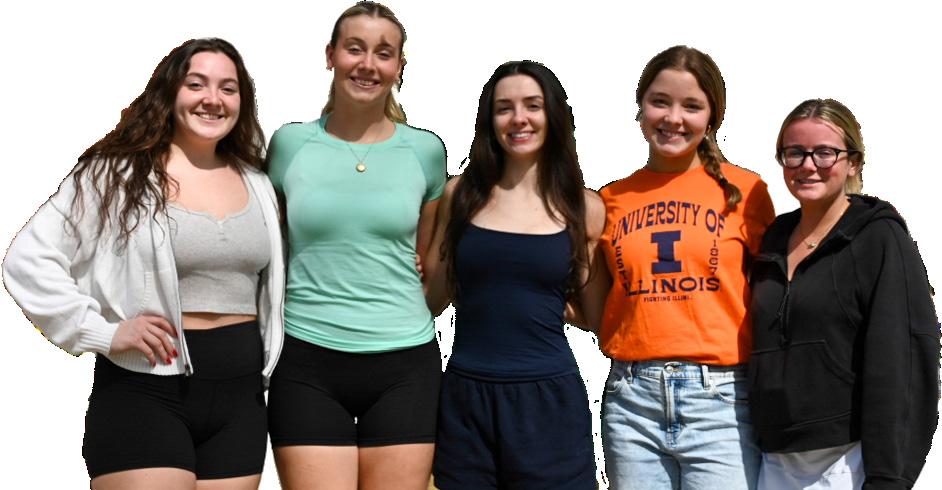
formation about each chapter and the Black Greek life experience.
“We’ll have representatives from each fraternity and sorority; we’ll answer the burning questions that many people outside of Greek life wouldn’t know the answer to,” Statam said. “After that, we give them some time to interact with the members of the organization.”
Based on details provided on their website, the UGC also participates in Meet The Greeks and Quad Day to introduce their chapters. However, each UGC chapter determines its timeline for taking in new members. Dates and times for informational meetings for each chapter can be found on flyers around campus.
The IFC’s recruitment process is also mainly informal, with chapter-specific events. Bodine mentioned his personal experience of finding friends on Quad Day and the benefit of getting to know each chapter on a more personal level through the IFC’s informal recruitment process.
In the fall, PHC participates in a formal recruitment process. After formal recruitment, certain chapters also host informal events.
Formal recruitment is a mutual selection process between potential new members and chapters. It begins with an orientation followed by four themed rounds. It builds up to Bid Day, when participants receive offers to join a chapter and head to their new chapter houses for
welcoming events, according to the council’s website.
Each council typically leads one or more annual council-wide initiatives while chapters engage in their individual philanthropic efforts.
One of PHC’s campus initiatives this past year was Hoops for Hope, a series of basketball tournaments in which all chapters on campus competed. The first-place prize was a check to the winning chapter’s philanthropy.
PHC Vice President of Recruitment Toni Reynolds, senior in LAS, explained the mindset the council takes on when choosing their campus initiatives.
“‘What is the greater U of I community looking for at this time?’” Reynolds said.
“I think that, with being the largest women’s RSO, we are able to make such a difference. It’s almost like if we don’t … ‘What is PHC? Why are we doing this?’”
Along with Hoops for Hope, PHC collaborated with IFC to actively recognize Sexual Assault Awareness Month this past year, Bodine said.
He also discussed the IFC’s council-led efforts aimed at addressing and ending sexual violence on campus.
“We had a fundraiser where we raised over $400 for R.A.C.E.S. (Rape Advocacy, Counseling, & Education Services) on campus,” Bodine said. “We also hosted a speaker about ending sexual assault and fighting back against that.”
Statam reflected on the

BGC’s council-wide initiative from the previous school year.
“The Black Greek Council also hosts service events monthly in which all of the active chapters participate,” Statam said. “One of the initiatives from last year was during Women’s History Month — we wrote letters to those who were victims of domestic violence.”
According to the UGC website, previous council initiatives involved making cards for local hospitalized children and delivering Valentine’s Day cards to residents of the Swann Special Care Center.
Board members also provided the size of their councils with clarifications on the included chapters.
Bodine said that the IFC
is a council made up of 35 different chapters with over 2,000 active members. He added that while not all are part of the North American Interfraternity Conference, most are.
Bodine clarified the potential misconception that the IFC includes all professional fraternities. However, some chapters have religious or vocational associations. There are also professional fraternities for fields like business, medicine and dentistry that function separately from the IFC.
Read the rest of this story online!
Scan the QR code or visit dailyillini.com to read the full story plus more!

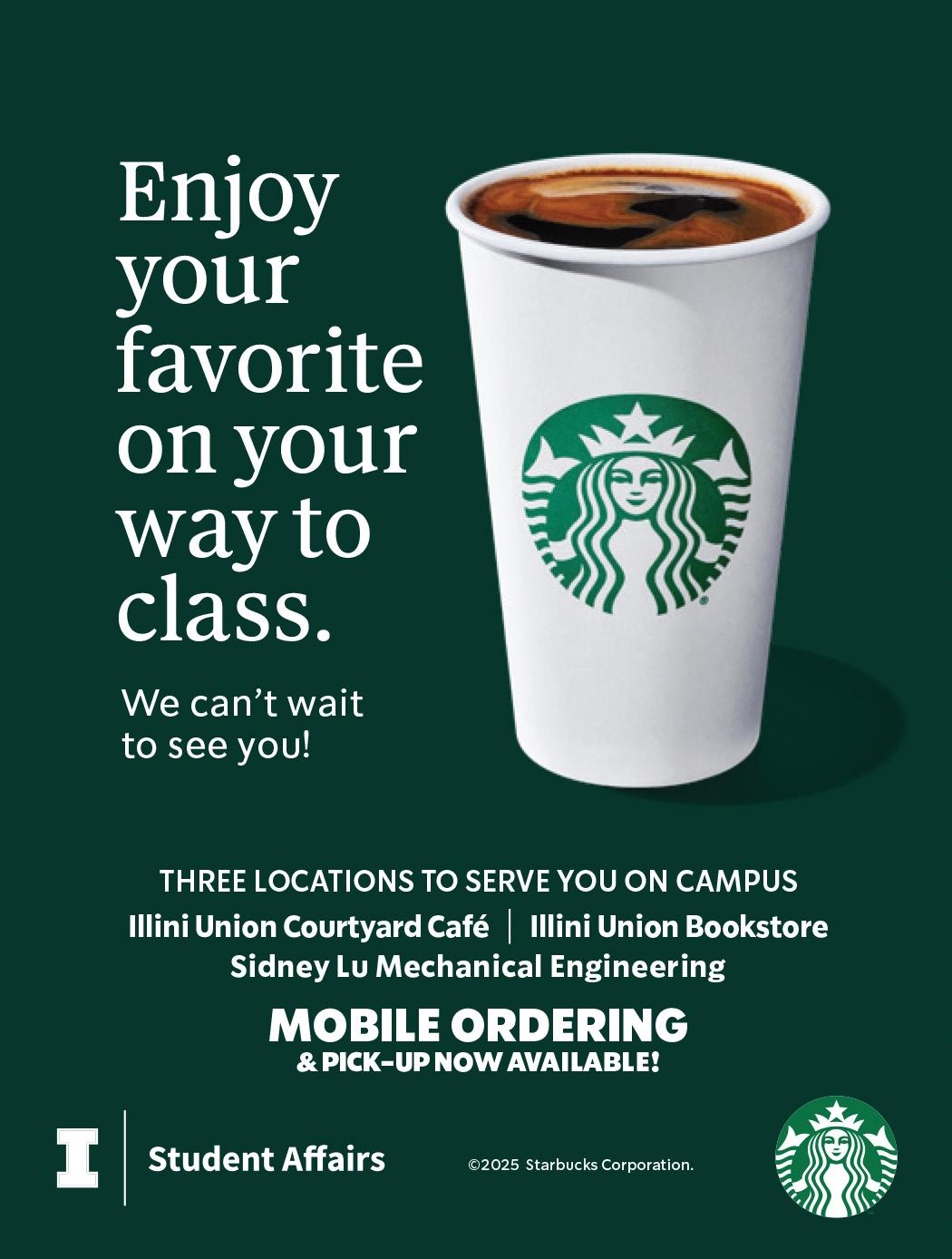










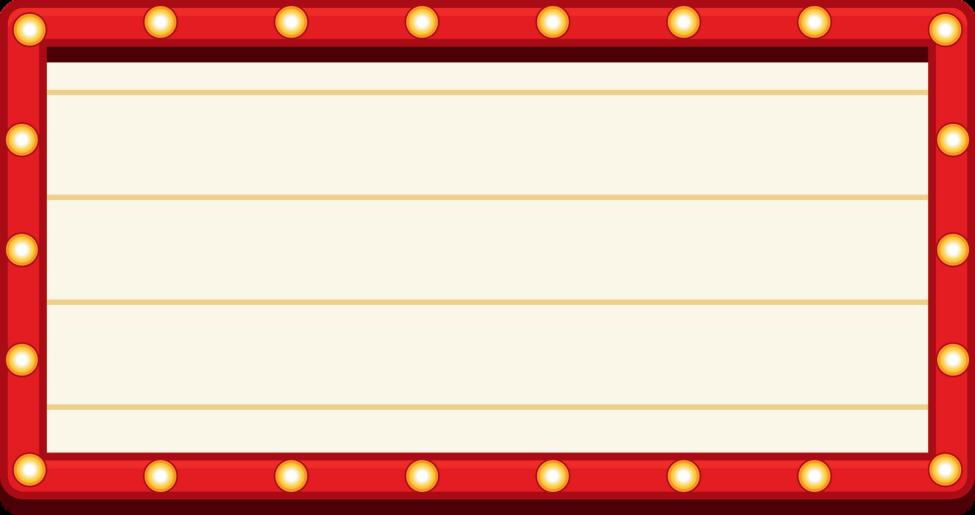





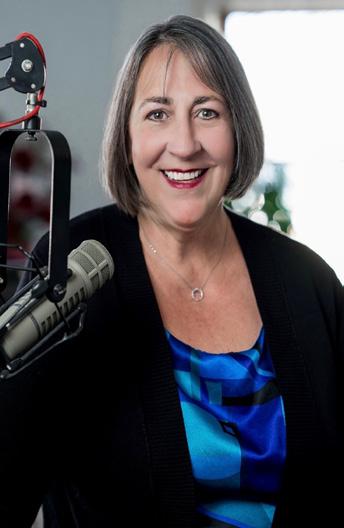


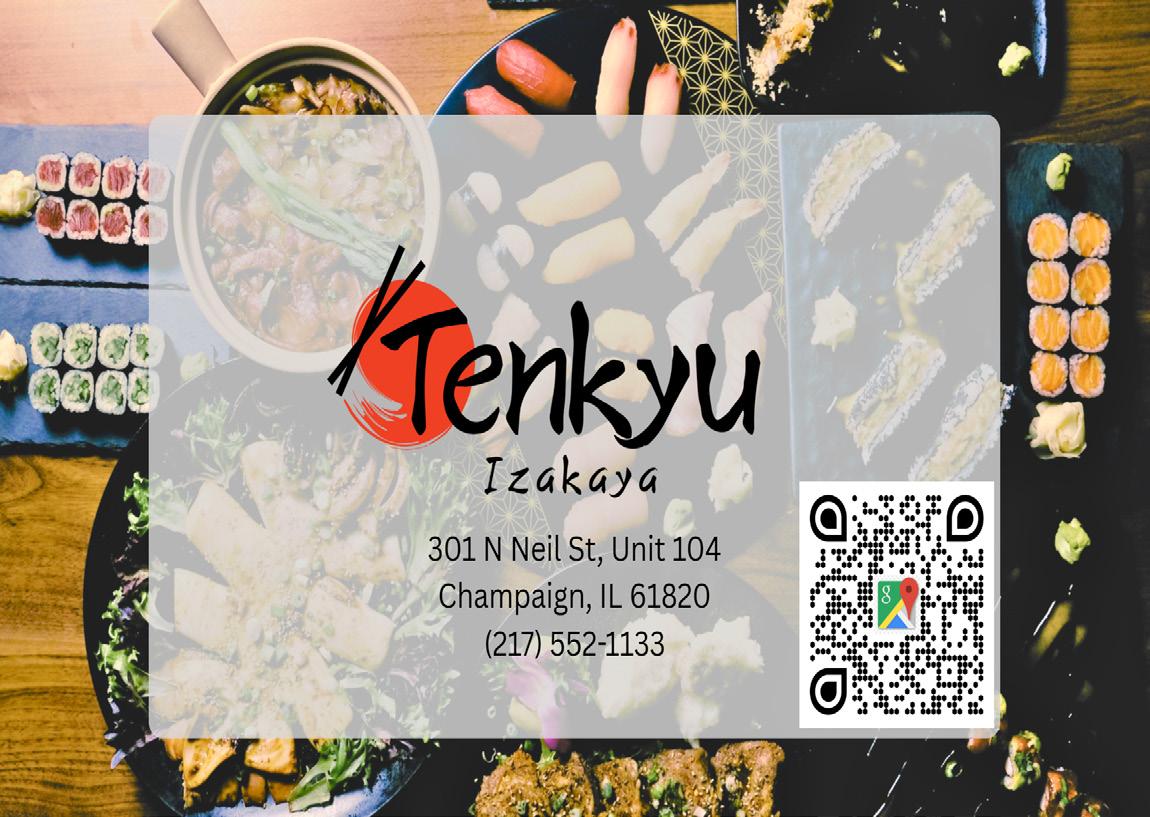


COLUMNIST ALEXANDER FAKO afako2@dailyillini.com
Bumping bass music. Strobe lights flash as you’re flashing in and out of fantastical consciousness. Your shoes are sticking to the ground with every step as if the floor is made of Hubba Bubba. Your fingers outstretched, trying to hold four plastic cups at once like it’s an Olympic sport.
Then, there’s a “bzzz, bzzz!” coming from the right pocket of your sweaty khaki shorts.
Ah, nuts. It’s 9:37 p.m. on a Thursday, and for whatev-
er reason, Mom’s decided to call you instead of sleeping like a normal old person.
They call at some bad times, don’t they?
You’re hit with a lot when you first come to college: classes, dining hall food, RSOs and bances. It’s hard to balance it all while you’re also learning to become independent. Doing the laundry and the dishes is more time-consuming than it seems. You’ll probably feel like there’s no time to keep in touch back home.
You’ll miss old friends, home-cooked meals and the hometown spots you memorized where the cops
watch for speeding.
There’s a fine line to walk when it comes to calling your parents in college. You should be enjoying yourself and all of the opportunities being a freshman in college offers.
Yet, college is just as tough a time for parents as it is for students. You shouldn’t dismiss them completely. Think about it: While you’re gaining different experiences at school, your parents have lost something back at home.
No more daily updates at the dinner table. No more parent-teacher conferences and, hopefully, no more helping you with your math
homework.
They miss your smile and watching you play T-ball more than they’re willing to admit. And they are, in all likelihood, the ones paying for you to be here.
While Mom may be inconveniently calling while you’re knee-deep in liquid courage, she’s back home. She misses you just as much as you miss her cooking.
Read the rest of this story online!
Scan the QR code or visit dailyillini.com to read the full story plus more!


SUMMER EDITOR
FELICITY ABBOTT fabbott2@dailyillini.com
As students enter college, their whole lives shift — including their diet. Eating healthy can seem impossible when faced with options like the University’s dining halls, especially with the freedom to eat a bag of chips for breakfast without parental judgment.
The University’s dining halls operate under an “all you care to eat” buffet model, where students use meal swipes to enter and are free to eat as much of whatever the dining halls serve at a particular time.
For new students nutritionally unaware, this can be a curse.
“In the dining halls, we try to offer things for everyone,” said Flora Mendoza, assistant director dietitian of Dining Services. “We’re not going to force you to eat healthy if you’d rather have chicken tenders and fries.”
A healthy visit to the dining hall may be a daunting task, but students who understand their nutritional needs and select their food wisely can set themselves up to feel their best.
“A helpful mindset is to always ask yourself, ‘What can I add in?’ instead of focusing on what to cut out,” wrote Ginny Williams, registered dietitian nutritionist and former Dining Services nutritionist, in an email. “If you’re craving pizza—go for it! Then ask yourself, ‘What
can I add to make this meal more nourishing?’”
Macronutrients can be the key to building a nourishing plate. The three macronutrients the body needs are protein, carbohydrates and fats. While carbohydrates and fats are sometimes stigmatized, all three macronutrients are essential.
“I feel like every year there’s a new fad diet that really messes with macros,” Mendoza said. “The secret is almost never to cut out an entire macronutrient group or to focus heavily on one.”
The internet’s latest craze is high-protein diets. Although this may seem like the healthy way to go, Mendoza believes most people can achieve their natural need for protein without solely focusing on the nutrient. Williams also warned of the dangers of listening to everything online.
“Here’s the truth: If it sounds too good to be true, it probably is,” Williams wrote. “If it sounds ‘diety,’ restrictive, or promises fast results, stay away. Real balance doesn’t come from rules—it comes from tuning in to what your body needs, not what an influencer says you should eat.”
Williams and Mendoza recommend that students research online to find nutrition information and listen to their bodies rather than falling victim to the internet’s spread of misinformation.
“We don’t need to eat seven chicken breasts a day as long as you are eating a bal-
anced diet,” Mendoza said.
A balanced diet consists of all three macronutrients, as well as the inclusion of dietary fiber — a nutrient Mendoza says very few Americans get sufficient amounts of.
“Eating fiber is kind of the best thing for your health,” said Mani Nakamura, professor in ACES.
Fiber and protein have the most satiating effects of the nutrients and can prevent unnecessary overeating, according to Nakamura.
Understanding personal nutrition can be difficult, especially for new students. As a result, the University provides resources to help students focus on their nourishment with the available dining options.
To view the nutritional breakdown of food in the dining halls, students can utilize the menus on the Illinois app or visit the EatSmart website.
Mendoza suggests reviewing these resources to understand the nutritional makeup of the foods students have to choose from.
“(Macronutrients) may not be as spot on, but always the macronutrients and the fiber, those are going to be entered by one of our menu management dietitians, and they are going to be accurate as long as you’re following the serving size,” Mendoza said.
The University also offers students the opportunity to speak with dietitians. On the Illinois app, students can text the dietitians of Dining Services with specif-
ic campus-related nutrition questions.
Nakamura proposed another way students can go about their diet mindfully.
“The important thing is not just what to eat,” Nakamura said. “How you eat is very important.”
He recommends that students eat three meals a day while sitting and refraining from snacking on the go. Rushing a meal or constantly snacking can lead to overeating, since the mind cannot register what is being eaten.
However, with this in mind, students can still recognize that they can fit some of their favorite foods into their balanced diet.
“If you’re most of the time focusing on nourishing your body with protein, fiber, healthy fats, and a variety of vitamins and minerals— there is absolutely room for your favorite treats,” Williams wrote. “Think of it like this: A balanced diet isn’t about perfection—it’s about patterns. You don’t have to ‘earn’ dessert, and you don’t need to cut it out to be healthy. Food is meant to nourish and be enjoyed.”
Thankfully, eating healthily doesn’t always have to mean cutting out ISR’s Andes mint pie.



SENIOR SPORTS REPORTER BEN SOMERVILLE bens4@dailyillini.com
After a promising season, Illinois football head coach Bret Bielema and his team are turning heads. They are coming off the fifth 10-win season in program history, and most of their starters are returning.
Illinois finished the year ranked in the AP Top 25 poll, which ranks the best college football teams in the nation. Multiple news outlets have placed the Illini high in their spring rankings, including ESPN, The Athletic and CBS.
With spirits high after last season and a loaded roster, the Illini are carrying heavy expectations on their shoulders. Before getting into this fall, here’s a look back at the historic 2024 season.
Illinois started the 2024 season red-hot. It went 4-0 and took down two ranked opponents in the process. A win over then-No. 22 Nebraska showed the nation that Illinois was a threat. Then-junior quarterback Luke Altmyer threw 10 touchdowns and no interceptions during the four-game span.
A resounding victory over then-No. 24 Michigan in October marked another high point of the year. It was the team’s first win against Michigan since 2009 and the third ranked win of the season. To
make it even more special, the game took place on the 100th anniversary of Memorial Stadium’s dedication.
The next two games were less than ideal for Illinois. It fell to then-No. 1 Oregon and Minnesota, both in demoralizing fashion. The losses all but guaranteed that the Illini would fall short of the College Football Playoff.
However, Illinois bounced back quickly, putting Michigan State in the dirt. It went on to dramatically beat Rutgers after then-senior Pat Bryant’s game-winning touchdown. To finish the season, the Illini got the victory over their in-state rival, the Northwestern Wildcats, to end the season 9-3.
An impressive season resulted in a bowl game against a highly ranked South Carolina team. The Illini were invited to the Cheez-It Citrus Bowl, where they took down the Gamecocks 21-17 on New Year’s Eve. The game gave Illinois its 10th win, making the season one of the best in team history.
As college football has evolved in recent years, the transfer portal has become increasingly prevalent. There’s no telling which player might decide to move to another team or take a big payday elsewhere. Fear of the transfer portal, and what they might lose, hovered over Illinois fans as the offseason loomed.

However, what happened was nearly the opposite of what many expected. Throughout the spring, Illini players announced their intent to stay with the team. Illinois has 16 starters returning, including multiple starting offensive linemen, top defensive players and key pieces on the offense.
Perhaps the most important of all, though, is Altmyer, who announced his senior season return during a men’s basketball game in December.
Illinois went to work in the transfer portal, filling in holes from the few leaving players. It added junior wide receiver Hudson Clement, who had over 1,000 yards in two seasons at West Virginia.
On the defensive side of the ball, the Illini scooped up former Wisconsin defensive lineman James Thompson Jr. He comes with 41 games of experience under his belt. The senior helps fill the hole made by former
Luke Altmyer winds up for a big throw as players clash around him during the Illinois vs. Purdue football game on Oct. 12, 2024, at Memorial Stadium.
defensive lineman TeRah Edwards and former linebacker Seth Coleman.
But it isn’t all good news in the portal. Longtime Illini running back Josh McCray entered the transfer portal and left for Georgia. The 6-foot-1 back put up 609 rushing yards and 10 touchdowns last season. He was crucial to the Citrus Bowl win and earned the MVP.
Illinois still stands to be one of the most experienced teams in the country, and its schedule is easier than last season’s. It has returned a multitude of starters and added more talent from the transfer portal. Best of all, the Illini held onto one of the top quarterbacks in the Big Ten.
The stars may be aligning for Illinois next season. The media seems to be high on the team, and fans certainly have high hopes after last season. Whether or not the Illini meet those standards remains to be seen, but there is plenty to be excited about as the season approaches.
SENIOR SPORTS REPORTER
BEN SOMERVILLE bens4@dailyillini.com
Throughout its storied history, Illinois football has faced a considerable number of opponents. However, three stand out as being the most hated by the team and fans alike. Whether it’s an in-state team or a long-time Big Ten foe, these teams have deep-rooted rivalries with the Illini. Purdue, Northwestern and Ohio State are some of Illinois’ biggest rivals. So big, in fact, that there is a trophy for the winner of each matchup between the teams.
The oldest of the three, the Illibuck, has been awarded to the winner of Illinois-Ohio State matchups since 1925. The victor received a living
2. Illinois hasn’t won since 2007 when it beat then-No. 1 Ohio State 28-21.
Illinois will have an opportunity to flip the script next season. The Buckeyes will travel to Champaign in early October, as the Illini will have a chance to recapture the Illibuck.
Northwestern and Illinois conclude every regular season with a battle for the Land of Lincoln trophy. While the series is old, the trophy is relatively new.
From 1945 to 2008, the winner acquired the Sweet Sioux Tomahawk trophy. The Illini held the edge over the Wildcats during that stretch, with a record of 33-29-2. The Land of Lincoln trophy, a top hat set on a wooden base, was introduced in 2009. The Illini have had less success with

However, head coach Bret Bielema has brought Illinois back from the dead. He is 3-1 against Northwestern and broke a six-game losing streak in his first season as head coach in 2021. At the end of this past season, Illinois beat Northwestern 38-28.
The Illini will get their next chance against the Wildcats on Nov. 29 at home.
Last but not least is arguably the most intense rivalry across all Illinois sports. The winner of Illinois-Purdue takes home the Cannon. Much like the rivalry, the trophy has a lengthy history.
A group of Purdue students brought the Cannon to an Illinois-Purdue game in 1905. They intended to fire it after a Boilermaker win. While Purdue did win, they never got a chance to fire the Cannon. It was left at the sta dium and found by Illinois student Quincy Hall.
Hall brought it to his home and left it there, where it survived a fire before be ing found years later. He donated the Cannon to Il linois in 1943, and it has symbolized the rivalry between Purdue and Illinois ever since.
Purdue has dominated the se ries with a record of 42-31-2. In the last decade, Illinois has only won three times, with the third being this past season.
In a thrilling match up, Illinois bested Purdue
in overtime 50-49. Despite leading by two scores in the fourth quarter, Illinois let Purdue take the lead with less than a minute left in regulation. But after kicking a field goal as time expired, the Illini sent the game to overtime.
The Illini were on offense first and scored almost immediately, as did the Boilermakers when they got a chance. As expected, Purdue lined up to go for the two-point conversion and win the game.
Yet, Purdue didn’t stand a chance. Junior linebacker Dylan Rosiek flew down the middle and sacked Purdue redshirt freshman quarterback Ryan Browne to seal the victory.
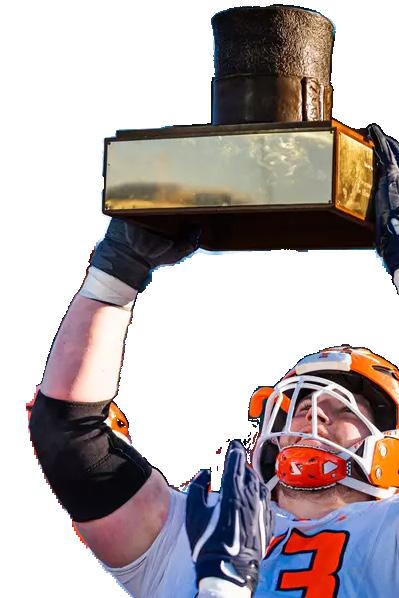



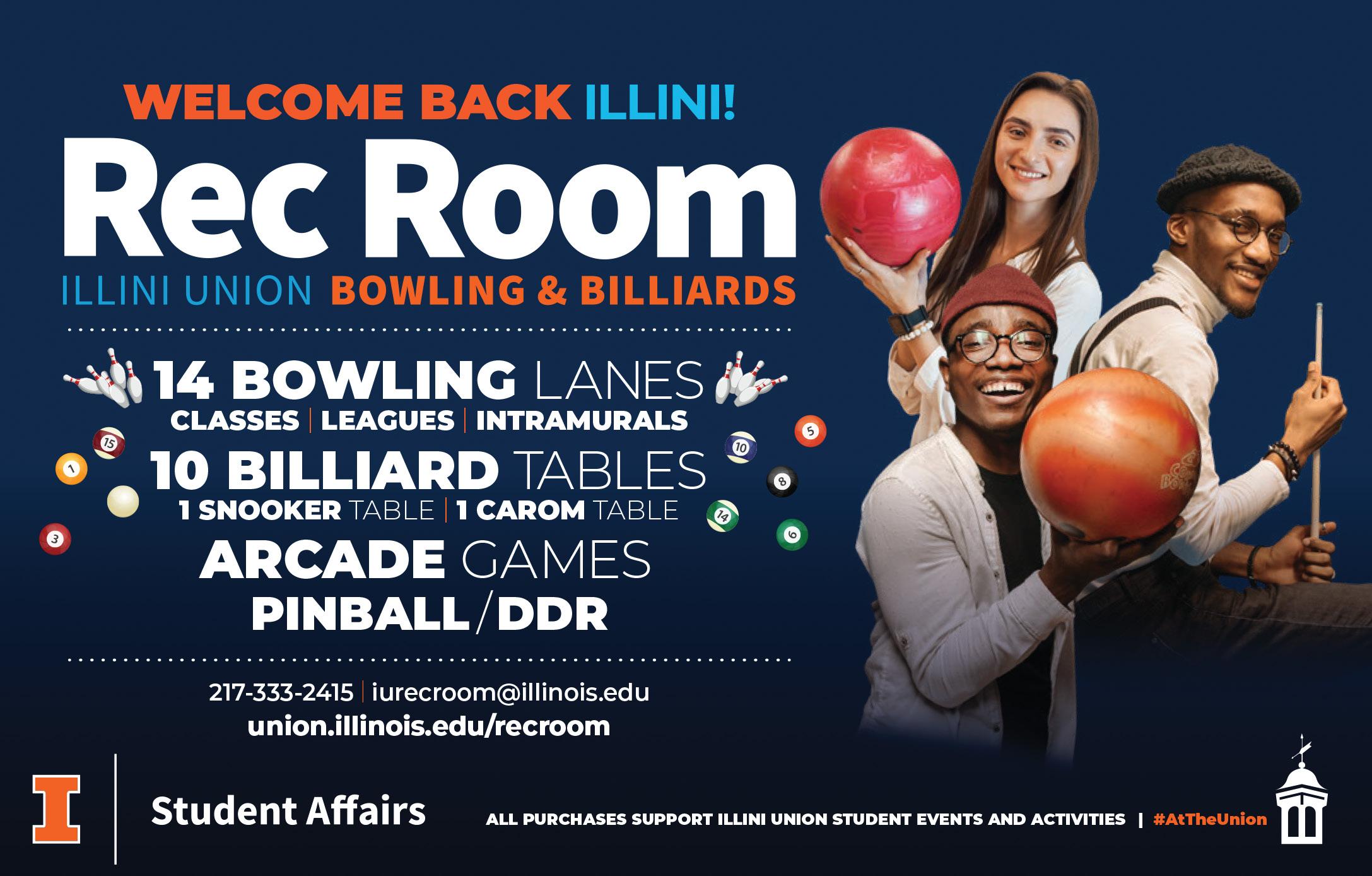
STAFF WRITER
MARIANA QUEZADA mquez3@dailyillini.com
Picture this: You’re a new student who has just arrived at the University. It’s a warm August afternoon, and you wonder what there is to do in the crown jewel of Central Illinois.
Aside from the multiple entertainment options scattered along Green Street and beyond, you can find an array of fun and free outdoor activities, perfect for when you need to reconnect with nature.
The keyword here is “free.” As any student can tell you, college isn’t exactly
the time to splurge.
These different experiences are also accessible by bus and are free with your i-card.
One of the most wellknown outdoor attractions on campus is the University of Illinois Arboretum, 160 acres of greenery located along Lincoln Avenue in Urbana.
You can reach the Arboretum by hopping on the 12 Teal bus route, which will take you straight to the gardens, with the PAR/FAR towers looming on the horizon.
In its own way, the Arboretum is Champaign-Urbana’s response to Manhattan’s Central Park. The botanical gardens are the place to escape the noise of campus life and
sit, read or stroll in nature.
It’s also home to Japan House, a facility known for its tea ceremonies. Some visitors, like Pam Brooks and Tom Dickens, a couple from Arizona, made a point to stroll around the famous Arboretum during their tour of the Midwest.
Brooks, a herbologist, highlighted the variety of plants and flowers featured in the gardens, as well as the size of the space.
“It’s really pretty,” Brooks said. “I like how they have a lot of labels, so I know the plants. It’s a nice place to walk and get a little exercise in the fresh air.”
If, when you visit the out-
doors, you dread the return to your cinderblock dorm, there’s no need to worry. You can get involved at places like the University of Illinois Plant Biology Greenhouse and spend more time with nature.
Compared to the Arboretum, the greenhouse is a hidden green gem, shrouded among the ivy-covered red-brick and limestone campus buildings.
Scan the QR code or visit dailyillini.com to read the full story plus more! Read the rest of this story online!


SENIOR COLUMNIST
RAPHAEL RANOLA
rrano2@dailyillini.com
Iused to live at the end of West Nevada Street in the brutal square building across the way from Caffe Paradiso and the adjacent Jimmy John’s. This was during my sophomore year, when, for many reasons, I spent more time alone. I was working on myself, and that meant spending many nights in.
I remember getting the Italian Night Club from Jimmy John’s and watching “Midnight in Paris” on my laptop, thinking Owen Wilson may be onto something. I’ve gone out plenty since then.
But the accumulation of all of these quiet nights made me better. They made me realize that — the brochures won’t tell you this — the entirety of college is a course on sitting with yourself.
This class taught me how to listen to the noise in my head without needing someone else’s music to drown it out.
I am no stranger to spending time alone: I spent the
summer after my sophomore year with my least favorite person, myself. I took two fairly rigorous classes and felt that I was learning a lot — academically and intrapersonally — without being distracted by my busy college life.
I didn’t have an internship then, but it felt like I was completing an internship with myself, putting in the work, cultivating growth and reading hard books. It was a nice change of pace from what seemed like near-constant “doing.” Melancholically, I fear I’ll never have a summer as pleasant as that.
If summer is when we sit with ourselves, the semester is when we perform. We party not just for fun, but as proof that we’re doing OK.
You might have picked up on the headline. If you’re even loosely familiar with “indie sleaze,” you’ll at least know LCD Soundsystem’s “Dance Yrself Clean” — a behemoth of a song that, to me, is about a generation dancing away in musty basements as the world burns around them.
It’s a hypnotic siren-song

around 15 years old about escapism — how the party scene can serve as relief, emotionally and spiritually. You shouldn’t feel discouraged because you’re alone in college. The people who appear the most put-together are often escaping something, too. According to the BBC, 40% of young adults globally report feeling lonely often or very often.
The essence of LCD Soundsystem’s angst is in its imagery: a musty basement, lit by the warm glow of people dancing themselves clean. We’re all acutely aware of what’s happening in the world around us — what else is there to do but dance? Sometimes, club classics are the only way to feel OK.
But that glow doesn’t last.
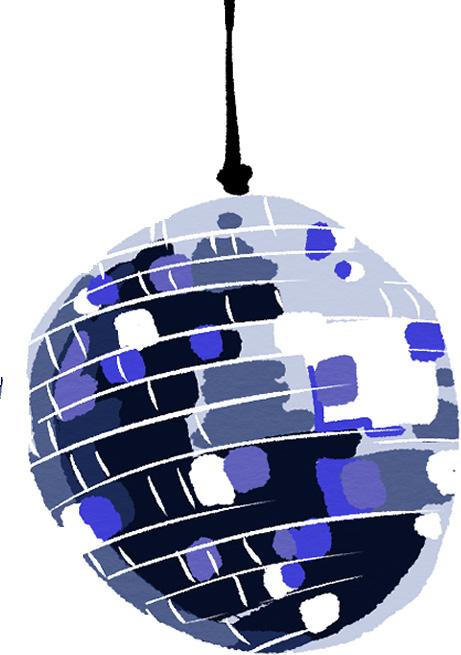
Escapism is nec essary, but it isn’t enough. The real work? That hap pens when the music stops. When you allow yourself to sit in the silence, embracing it alone.
College will teach you a lot. Some of it happens in classrooms. The rest — the most important parts — happen when you’re alone, figuring out how to be okay without an audience.
You’ll learn how to dance — and when it’s time to go home.
If you’re lonely, don’t panic. You’re not broken — just enrolled in one of the harder classes. And in that vein, it’s just something you get better at, each day at a time.
Raphael is a senior in ACES and is presently dancing himself clean.





EDITOR-IN-CHIEF
SAM GREGERMAN sg94@dailyillini.com
If you were to tell me at 18 that I would confidently call myself a journalist at 21, I would be confused. More so, if you told me I was the Editor-in-Chief of my college newspaper, I would be dumbfounded.
As a sophomore in college, I transferred to the University looking for a purpose — I just didn’t know what that was yet.
I stumbled into one of The Daily Illini’s recruitment nights without a lick of journalism experience. All I knew was I loved to write, and this was an opportunity to channel that passion somewhere.
One thing led to the next, and I entered a world where I learned to pitch stories, approach strangers for interviews and churn out articles overnight so they wouldn’t lose their “news peg.”
I gradually moved up the ranks, finding something new to appreciate every day about the intrinsic storytelling that is journalism.
Now, I’m the one in charge. I rode this newfound passion all the way to Editor-in-Chief, fueled by an excitement I had never felt before. Suddenly, I understood what people meant when they said it doesn’t feel like work when you love what you do.
I could see a crystal clear future of a post-graduate life as a reporter. I finally felt like I
had found my “thing.”
It wasn’t all sunshine and rainbows getting here, though. It took a whole year of feeling wrong before I even ventured toward the direction of right.
Three years ago, I was a senior in high school, frantically trying to figure out where I would be going to school. I was a wreck. I felt like I was alone on an abandoned boat in the middle of the ocean, stranded and desperate as I watched my peers celebrate and swim to shore.
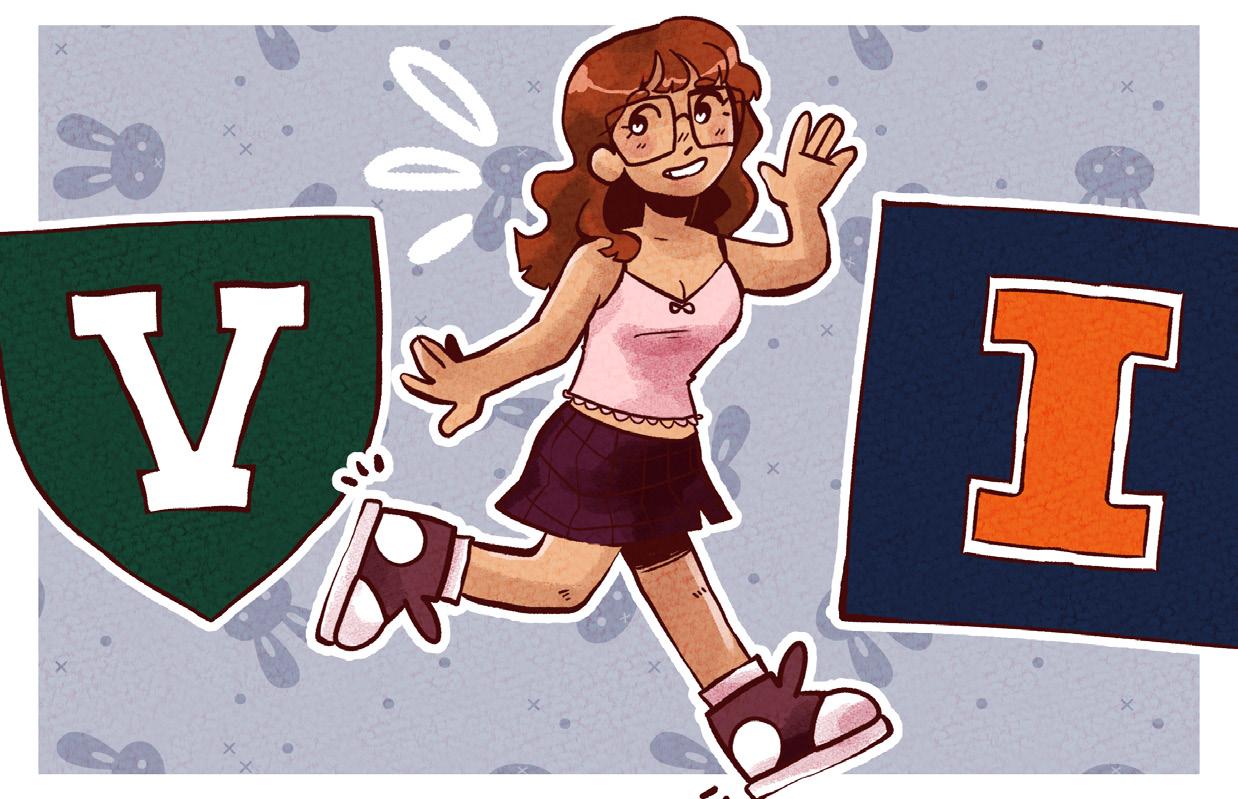
I took my merit scholarship and ran away to the University of Vermont, looking for something I was convinced I couldn’t find in-state.
After growing up in the same Midwestern suburb my whole life, Vermont felt like a glowing beacon of opportunity to experience something unfamiliar.
I arrived in Vermont ripe with awe at the concept of independence in a state where I could wave good morning to the mountains on my way to the dining hall for breakfast.
But I didn’t find what I was looking for there. Yes, I learned a host of lessons about independence and introspection, but I didn’t feel at home.
It became very clear to me that I needed to try again, and I thank myself for realizing and acting on that every single day I spend
It became very clear to me that I needed to try again, and I thank myself for realizing and acting on that every single day I spend here at the University.
here at the University.
Naturally, it took some trial and error here too — with classes, dating, friends and part-time jobs. But never with writing.
No matter what insurmountable obstacles I faced, I suddenly had journalism to fall back on. I could lose myself in telling other people’s stories when the weight of the world got a little too heavy for my shoulders.
It wasn’t just the work, though. It was the people. For the first time in my college career, I felt at home. I was surrounded by a group
who felt as excited about covering Election Day from dawn to dusk as I did.
At The DI, I found passion. I found camaraderie and my senior-year roommates. I found experiences that permanently imprinted themselves in my memories. I uncovered my place.
I truly believe that I wouldn’t have discovered any of this without my time in Vermont. For me, transferring was about continuing to search for myself, and I wouldn’t be the same person I am today without the less successful year I spent pursuing that mission.
I don’t regret anything. If I could go back and do it all over again, I wouldn’t change a thing. Every lesson I learned in Vermont I took back to Illinois, and every lesson I’ve learned at the University has shaped me into the person I am today. The person I can smile back at in the mirror, knowing I tried my absolute hardest. And that effort paid off.
